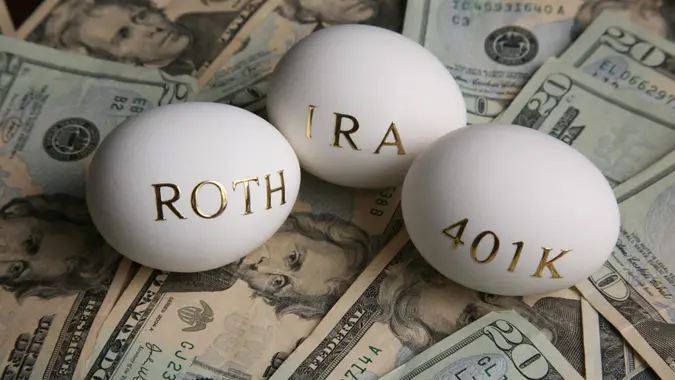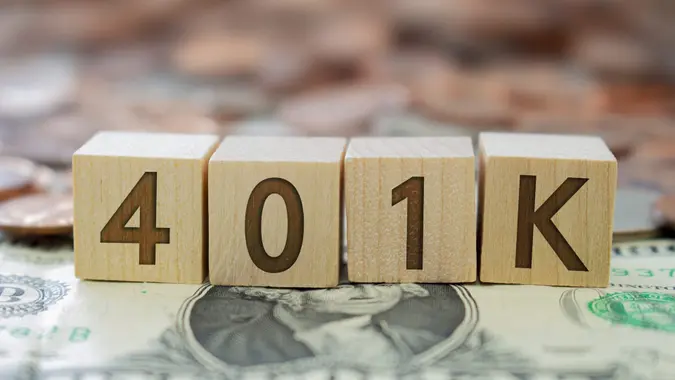How Much You’d Need To Retire in 1965 vs. 2025 — the Numbers Will Shock You

Commitment to Our Readers
GOBankingRates' editorial team is committed to bringing you unbiased reviews and information. We use data-driven methodologies to evaluate financial products and services - our reviews and ratings are not influenced by advertisers. You can read more about our editorial guidelines and our products and services review methodology.

20 Years
Helping You Live Richer

Reviewed
by Experts

Trusted by
Millions of Readers
Retiring comfortably in 1965 was a lot different from retiring today. And by different, we mean a lot less expensive, like buying a house on one salary, or buying pretty much anything on only one salary.
Back in 1965, a modest retirement fund supplemented by a company pension and Social Security could ensure a comfortable retirement lifestyle. People retiring today, or looking 10 to 15 years down the road towards retirement, face a dramatically different landscape.
In 2025, the “magic number” most Americans think they need to retire comfortably is $1.26 million, according to Kiplinger. That kind of money (even adjusted for inflation to the equivalent of 1965, sixty years ago) would have seemed astronomical to previous generations.
Let’s compare and contrast the costs of retirement in 1965 with today’s retirement expenses.
What Retirement Was Like in 1965
The 1960s were a golden age for the American pension system. Life expectancy hovered around 70.2 years, meaning most retirees enjoyed relatively short retirement periods of 5 to 10 years. As a result, this significantly reduced the total amount needed for retirement.
In 1960, the median value of people’s homes was $11,900. And in 1965, this was remarkably affordable by today’s standards. Groceries, healthcare, holidays, and putting gas in the car consumed a much smaller percentage of household budgets. Healthcare expenses, in particular, were a fraction of what older generations have to pay today.
Most importantly, the retirement funding equation was so much different compared to today.
Company-sponsored defined-benefit pensions provided guaranteed monthly payments for life, often replacing 60%-70% of pre-retirement income when combined with Social Security.
As a result, personal savings targets were much lower. On average, this could have meant only needing to personally save $30,000-$50,000 to fill any remaining gaps, although there is no authoritative source that confirms the exact amount of savings they did have or really needed.
As a result of government reforms in the wake of the Great Depression, the pension system essentially socialized retirement risk across large employer groups and professional pension managers.
What Retirement Is Like in 2025
In comparison, today’s retirement picture is far more complex and demanding. Life expectancy has increased to the mid-to-late 70s and is likely to stretch into the 80s as health technologies get better.
Many retirees are now planning for 20 to 30 years of post-work life. This has doubled or tripled the total funding requirements for retirement.
Retirees in the U.S. spend an average of around $5,000 per month to cover living expenses, healthcare, travel, and leisure activities. Older people want to live life to the fullest for as long as possible, so hobbies and travel are much bigger parts of retirement.
This comes out to $60,000 annually. Healthcare costs have become one of the largest retirement expenses, often consuming 15% to 20% of a retired couple’s total budget.
The shift from defined-benefit pensions to defined-contribution plans like 401(k)s and IRAs has transferred retirement risk from employers to individuals.
Experts recommend saving 10x your income by age 67. All of this is why Americans think they need $1.26 million to retire comfortably in 2025. However, according to GOBankingRates research, current savings fall far short of these targets, with the average retirement savings at $333,940 across all age groups.
The Numbers Side-by-Side
The raw numbers reveal the dramatic shift in retirement costs over 60 years:
- Housing: Median home value was $11,900 in 1960, and it wasn’t much more in 1965. In 2025, the median price for a home will have soared to approximately $410,800 nationally. That is a massive 35-fold increase that far outpaces inflation and wage increases in that same timescale.
- Income Ratios: In 1965, the median household income was approximately $6,900, according to census data. In comparison, the median household income is about $84,000. While this represents roughly a 12-fold increase, housing costs have increased at nearly triple that rate.
- Healthcare Impact: Healthcare represented a minor expense for 1960s retirees. In most cases, this was covered by employer plans or modest out-of-pocket costs. Today, healthcare is one of the biggest components of the $5,000 monthly spending average for retirees.
- The Inflation Reality: Housing costing $40,000 in 1967 would cost nearly half a million in 2025, showing how dramatically housing inflation has outpaced general price increases.
Why the Gap Is So Huge
Several factors have created this retirement funding chasm:
- Inflation Compounding: Sixty years of inflation have eroded purchasing power, but housing and healthcare have inflated at rates far exceeding the Consumer Price Index (CPI).
- The Pension Revolution: The shift from guaranteed pensions to self-directed retirement accounts has fundamentally changed retirement planning. Where previous generations could rely on predictable monthly pension checks, today’s retirees must manage investment risk, withdrawal rates, and sequence-of-returns risk independently.
- Healthcare Cost Explosion: Medical expenses have grown from a minor retirement concern to often the largest single category of spending. Advanced medical technology, medicines, and longer lifespans have created healthcare cost burdens unimaginable to most people in 1965.
- Lifestyle Evolution: Modern retirees often expect active lifestyles, including travel, dining, entertainment, and technology that were either unavailable or only available to millionaires in previous generations.
- Longer Lifespans: In this case, the maths are unforgiving. Funding 25 to 30 years of retirement requires dramatically more capital than funding 10 to 15 years. And this is before accounting for inflation.
Shocking Cost of Retiring in 2025
Many Americans retired comfortably in 1965 with nest eggs worth less than $100,000. A comfortable combination of pensions, Social Security, and modest savings provided security that seems almost quaint by current standards.
Sixty years later, even $1 million may prove inadequate, particularly in high-cost states where housing and living expenses consume retirement funds rapidly. Using the traditional 4% withdrawal rule, a $1 million portfolio generates $40,000 annually before taxes. This is barely two-thirds of the $60,000 desired average annual spending reported for current retirees.
The sobering reality is that $100,000 in 1965 purchasing power equals approximately $1 million today when adjusted for inflation. However, the actual funding needs have grown far beyond simple inflation adjustments due to healthcare costs, longer lifespans, and more financially demanding lifestyle expectations.
This transformation represents one of the most significant economic shifts in American history, fundamentally altering the relationship between work, savings, and retirement security. Understanding these changes is crucial for anyone planning their financial future in an era where individual responsibility for retirement funding has largely replaced the collective security of the pension era.
 Written by
Written by  Edited by
Edited by 

























